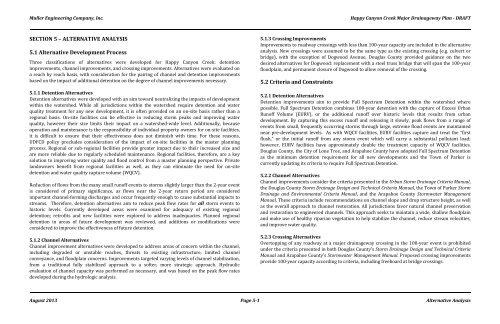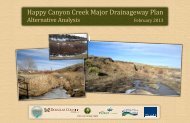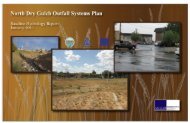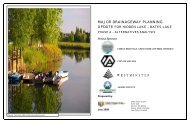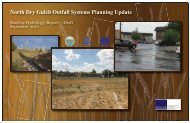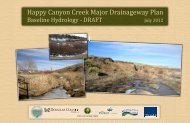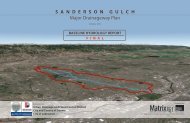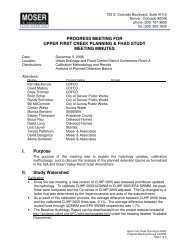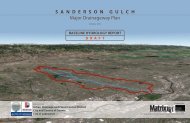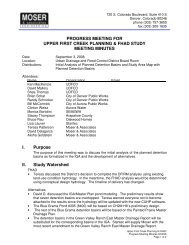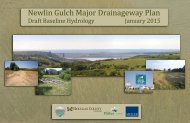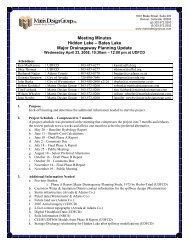PDF (53.8 MB) - Urban Drainage and Flood Control District
PDF (53.8 MB) - Urban Drainage and Flood Control District
PDF (53.8 MB) - Urban Drainage and Flood Control District
Create successful ePaper yourself
Turn your PDF publications into a flip-book with our unique Google optimized e-Paper software.
Muller Engineering Company, Inc.<br />
Happy Canyon Creek Major <strong>Drainage</strong>way Plan - DRAFT<br />
SECTION 5 – ALTERNATIVE ANALYSIS<br />
5.1 Alternative Development Process<br />
Three classifications of alternatives were developed for Happy Canyon Creek: detention<br />
improvements, channel improvements, <strong>and</strong> crossing improvements. Alternatives were evaluated on<br />
a reach by reach basis, with consideration for the pairing of channel <strong>and</strong> detention improvements<br />
based on the impact of additional detention on the degree of channel improvements necessary.<br />
5.1.1 Detention Alternatives<br />
Detention alternatives were developed with an aim toward neutralizing the impacts of development<br />
within the watershed. While all jurisdictions within the watershed require detention <strong>and</strong> water<br />
quality treatment for any new development, it is often provided on an on-site basis rather than a<br />
regional basis. On-site facilities can be effective in reducing storm peaks <strong>and</strong> improving water<br />
quality, however their size limits their impact on a watershed-wide level. Additionally, because<br />
operation <strong>and</strong> maintenance is the responsibility of individual property owners for on-site facilities,<br />
it is difficult to ensure that their effectiveness does not diminish with time. For these reasons,<br />
UDFCD policy precludes consideration of the impact of on-site facilities in the master planning<br />
process. Regional or sub-regional facilities provide greater impact due to their increased size <strong>and</strong><br />
are more reliable due to regularly scheduled maintenance. Regional facilities, therefore, are a key<br />
solution to improving water quality <strong>and</strong> flood control from a master planning perspective. Private<br />
l<strong>and</strong>owners benefit from regional facilities as well, as they can eliminate the need for on-site<br />
detention <strong>and</strong> water quality capture volume (WQCV).<br />
Reduction of flows from the many small runoff events to storms slightly larger than the 2-year event<br />
is considered of primary significance, as flows near the 2-year return period are considered<br />
important channel-forming discharges <strong>and</strong> occur frequently enough to cause substantial impacts to<br />
streams. Therefore, detention alternatives aim to reduce peak flow rates for all storm events to<br />
historic levels. Currently developed areas were examined for adequacy of existing regional<br />
detention; retrofits <strong>and</strong> new facilities were explored to address inadequacies. Planned regional<br />
detention in areas of future development was reviewed, <strong>and</strong> additions or modifications were<br />
considered to improve the effectiveness of future detention.<br />
5.1.2 Channel Alternatives<br />
Channel improvement alternatives were developed to address areas of concern within the channel,<br />
including degraded or unstable reaches, threats to existing infrastructure, limited channel<br />
conveyance, <strong>and</strong> floodplain concerns. Improvements targeted varying levels of channel stabilization,<br />
from a traditional fully stabilized approach to a softer, more strategic approach. Hydraulic<br />
evaluation of channel capacity was performed as necessary, <strong>and</strong> was based on the peak flow rates<br />
developed during the hydrologic analysis.<br />
5.1.3 Crossing Improvements<br />
Improvements to roadway crossings with less than 100-year capacity are included in the alternative<br />
analysis. New crossings were assumed to be the same type as the existing crossing (e.g. culvert or<br />
bridge), with the exception of Dogwood Avenue. Douglas County provided guidance on the two<br />
desired alternatives for Dogwood: replacement with a steel truss bridge that will span the 100-year<br />
floodplain, <strong>and</strong> permanent closure of Dogwood to allow removal of the crossing.<br />
5.2 Criteria <strong>and</strong> Constraints<br />
5.2.1 Detention Alternatives<br />
Detention improvements aim to provide Full Spectrum Detention within the watershed where<br />
possible. Full Spectrum Detention combines 100-year detention with the capture of Excess <strong>Urban</strong><br />
Runoff Volume (EURV), or the additional runoff over historic levels that results from urban<br />
development. By capturing this excess runoff <strong>and</strong> releasing it slowly, peak flows from a range of<br />
events from small, frequently occurring storms through large, extreme flood events are maintained<br />
near pre-development levels. As with WQCV facilities, EURV facilities capture <strong>and</strong> treat the “first<br />
flush,” or the initial runoff from any storm event which will carry a substantial pollutant load;<br />
however, EURV facilities have approximately double the treatment capacity of WQCV facilities.<br />
Douglas County, the City of Lone Tree, <strong>and</strong> Arapahoe County have adopted Full Spectrum Detention<br />
as the minimum detention requirement for all new developments <strong>and</strong> the Town of Parker is<br />
currently updating its criteria to require Full Spectrum Detention.<br />
5.2.2 Channel Alternatives<br />
Channel improvements consider the criteria presented in the <strong>Urban</strong> Storm <strong>Drainage</strong> Criteria Manual,<br />
the Douglas County Storm <strong>Drainage</strong> Design <strong>and</strong> Technical Criteria Manual, the Town of Parker Storm<br />
<strong>Drainage</strong> <strong>and</strong> Environmental Criteria Manual, <strong>and</strong> the Arapahoe County Stormwater Management<br />
Manual. These criteria include recommendations on channel slope <strong>and</strong> drop structure height, as well<br />
as the overall approach to channel restoration. All jurisdictions favor natural channel preservation<br />
<strong>and</strong> restoration to engineered channels. This approach seeks to maintain a wide, shallow floodplain<br />
<strong>and</strong> make use of healthy riparian vegetation to help stabilize the channel, reduce stream velocities,<br />
<strong>and</strong> improve water quality.<br />
5.2.3 Crossing Alternatives<br />
Overtopping of any roadway at a major drainageway crossing in the 100-year event is prohibited<br />
under the criteria presented in both Douglas County’s Storm <strong>Drainage</strong> Design <strong>and</strong> Technical Criteria<br />
Manual <strong>and</strong> Arapahoe County’s Stormwater Management Manual. Proposed crossing improvements<br />
provide 100-year capacity according to criteria, including freeboard at bridge crossings.<br />
August 2013 Page 5-1 Alternative Analysis


